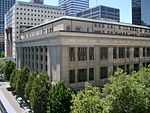The Quest (Portland, Oregon)

The Quest, sometimes referred to as Saturday Night at the Y or Three Groins in a Fountain, is an outdoor marble sculpture and fountain designed by Count Alexander von Svoboda, located in Portland, Oregon in the United States. The sculpture, carved in Italy from a single 200-ton block of white Pentelic marble quarried in Greece, was commissioned by Georgia-Pacific in 1967 and installed in front of the Standard Insurance Center in 1970. It depicts five nude figures, including three females, one male and one child. According to the artist, the subjects represent man's eternal search for brotherhood and enlightenment. As of 1990, The Quest was considered Portland's largest single piece of white sculptured marble. The abstract, figurative sculpture was surveyed by the Smithsonian Institution's "Save Outdoor Sculpture!" program in 1994 and underwent minor repairs. It has received mixed reviews. One critic appreciated how its flowing lines contrasted with the "stark" pillars of the adjacent building, and called the marble "impressive". Another writer for The Oregonian wrote of her and others' dislike for the sculpture, saying it serves as a "free sex-education lesson" for schoolchildren.
Excerpt from the Wikipedia article The Quest (Portland, Oregon) (License: CC BY-SA 3.0, Authors, Images).The Quest (Portland, Oregon)
Southwest 5th Avenue, Portland Downtown
Geographical coordinates (GPS) Address External links Nearby Places Show on map
Geographical coordinates (GPS)
| Latitude | Longitude |
|---|---|
| N 45.51714 ° | E -122.67822 ° |
Address
The Quest
Southwest 5th Avenue
97204 Portland, Downtown
Oregon, United States
Open on Google Maps







